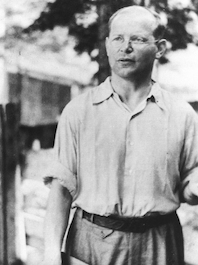Why totalitarian regimes make so many martyrs
- FATHER RAYMOND J. DE SOUZA
The history of the Church is written in the blood of the martyrs.
 Dietrich Bonhoeffer
Dietrich Bonhoeffer1906-1945
Amongst that white-robed army the class of 1945 wrote some bold lines. As the coronavirus put paid to many of the 75th anniversary commemorations of the end of World War II, an ancillary consequence was that some of the most inspiring Catholic martyrs of that year have not had the recognition they deserve.
Dietrich Bonhoeffer, one of the brightest witnesses of Christian resistance to 20th-century totalitarianism, was a Lutheran rather than a Catholic, but his famous death illustrates much about that year. Bonhoeffer was killed when the war was already lost. There was no strategic point to his death; it was a matter of inflicting cruelty upon religious believers for the sake of it.
Bonhoeffer was executed at Flossenbürg on April 9 1945, just two weeks before American forces liberated the camp, three weeks before Hitler's suicide and a month before V-E Day. The Nazi regime knew it was defeated, yet it inflicted a terrible blow on the Christian Church; imagine what Bonhoeffer would have contributed to the reconstruction of the German soul after the war.
On the other side of the world, Blessed Peter To Rot died in July 1945, killed by the Japanese a month before their own surrender. Blessed Peter was a catechist in his local parish in Papua New Guinea. Under Japanese occupation the foreign missionary priests were expelled, so Peter was put in charge of keeping the parish as vital as was possible without priests. He did so with creativity and courage, first openly and then clandestinely after the Japanese banned all religious services.
The Japanese decreed that the islanders should return to polygamy, which they had abandoned when they became Christians. Peter staunchly defended Christian marriage, the vocation he lived as a husband and father. He was imprisoned in early 1945 and killed by lethal injection in July. His killers, like those of Bonhoeffer, knew that they had already lost the war.
Another martyr, Rolando Rivi of Italy, was killed as a sign that fascist totalitarianism would give way to communist totalitarianism. The regimes would change, the martyrdoms would continue.
In June 1944, the Nazis were being pushed back in France, but they still had their hold on northern Italy. That month German troops occupied the minor seminary where Rolando studied and shut it down, expelling the seminarians. Rolando returned to his village of San Valentino, keeping up the seminary schedule and studies as best as he could and wearing his cassock, as was the custom of the time.
...Dachau, called the "largest monastery" in the history of the world for the thousands of priests interned there.
"I study to be a priest, and these vestments are the sign that I belong to Jesus," Rolando told those, including his parents, who were worried that his public witness would mean danger.
The anti-fascist partisans in Italy included many communists. The communists had killed four priests in the area, and San Valentino's parish priest was moved away for his safety after being attacked. In April 1945, the communist partisans seized Rolondo, stripped him of his cassock and tortured him for three days. The communists killed him, even though he was only 14 years old, because, as one killer put it, it would mean "one less future priest". The new communist future would be killing a lot of priests.
The Albanian martyrs were some of the first to face the lethal descent of the Iron Curtain. The martyrdoms started in 1945, with those beatified in 2016 including two bishops, 21 diocesan priests, seven Franciscans, three Jesuits, one seminarian and four lay persons.
There are others too in the class of 1945. Many are in the group of 108 Polish martyrs beatified by St. John Paul in 1999, which included three bishops, 79 priests, seven male religious, eight female religious and 11 lay people.
One cannot forget Blessed Karl Leisner, the deacon who was interned for years at Dachau, called the "largest monastery" in the history of the world for the thousands of priests interned there. Leisner was secretly ordained a priest in Dachau by a fellow prisoner, a French bishop. He was so weak that he only managed to celebrate a single Mass after his ordination; he survived the liberation of Dachau in April 1945 and died in August. He was beatified as a martyr, one of the most inspiring stories of World War II.
The martyrs of 1945 demonstrate that the killing of Christians is not a utilitarian matter for totalitarians. It is an essential matter, even when, or perhaps especially when, unnecessary.
 This is Fraser Field, Founder of CERC. I hope you appreciated this piece. We curate these articles especially for believers like you.
This is Fraser Field, Founder of CERC. I hope you appreciated this piece. We curate these articles especially for believers like you.
Please show your appreciation by making a $3 donation. CERC is entirely reader supported.

Acknowledgement
 Father Raymond J. de Souza. "Why totalitarian regimes make so many martyrs." Catholic Herald (August 6, 2020).
Father Raymond J. de Souza. "Why totalitarian regimes make so many martyrs." Catholic Herald (August 6, 2020).
The Catholic Herald is a London-based magazine, established as a newspaper in 1888 and published in the United Kingdom and the Republic of Ireland.
The Author
Father Raymond J. de Souza is the founding editor of Convivium magazine.
Copyright © 2020 Catholic Herald

